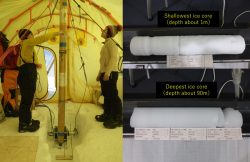
The air in the United States and Western Europe is much cleaner than even a decade ago. Low-sulfur oil standards and regulations on power plants have successfully cut sulfate concentrations in the air, reducing the fine particulate matter that harms human health and cleaning up the environmental hazard of acid rain.
Despite these successes, sulfate levels in the atmosphere have declined more slowly than sulfur dioxide emissions, especially in wintertime. This unexpected phenomenon suggests sulfur dioxide emission reductions are less efficient than expected for cutting sulfate aerosols. A new study led by the Tokyo Institute of Technology, Hokkaido University and the University of Washington explains why. The open-access paper was published May 5 in Science Advances.
When concentrations of acidic sulfate from fossil fuel emissions decrease while the concentration of more basic ammonium molecules in the atmosphere stay constant, liquid water droplets in clouds become less acidic. This makes conversion of sulfur dioxide to sulfate more efficient. So, even though air quality regulations have reduced the supply of sulfur dioxide from power plants and shipping, the total amount of sulfate particulates that harm human health has dropped more slowly.
“It does not mean that the emissions reductions aren’t working. It’s just that there is a reaction which partially mitigates the reductions,” said co-author Becky Alexander, director of the UW Program on Climate Change and professor of atmospheric sciences. “We need to understand this multiphase chemistry in the atmosphere to make an efficient strategy to manage air pollution and accurately predict future air pollution and climate change impacts.”
During most of the 20th century, sulfur dioxide emissions increased with industrialization in many parts of the world. But recently that trend has reversed in response to regulations, while ammonium emissions from animals and agriculture continue at the same rate. These trends are expected to continue.
Read more at UW News »
